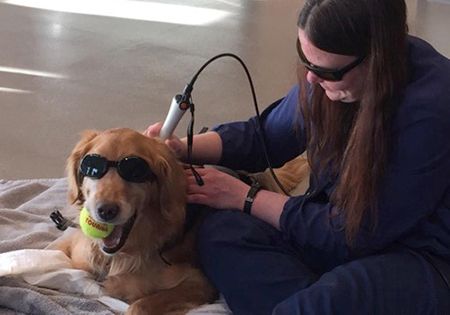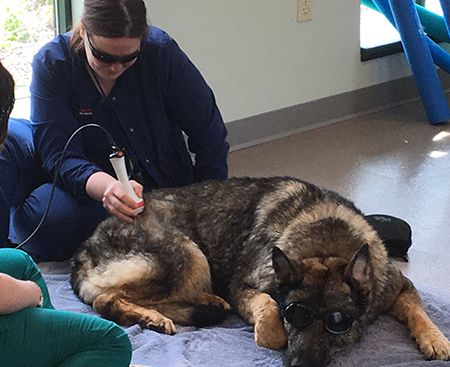Photobiomodulation facts and functions in veterinary rehab
More commonly known as laser therapy, let's take a look at what we currently know about how it can help many of your veterinary patients.

Bonus of photobiomodulation therapy: You look cool! (Photo courtesy of Dr. Matthew Brunke)The terminology can get quite confusing. “Cold lasers,” “therapy lasers,” “low-level lasers”-which do we choose? Photobiomodulation is defined as “nonthermal interaction of monochromatic radiation with a target site.” This just became a searchable term on PubMed recently, so there's still a lot of variation and confusion. For the purposes of this article, we will use the term photobiomodulation therapy (PBMT).
Rehabilitation is becoming a standard of care in veterinary medicine. As this field grows and owners' expectations for compassionate care and return to function and activity expand, there's a need to offer better and faster options. PBMT is a vital and practical cog in the wheel of rehabilitative options.
It can be utilized for a wide variety of cases, making it a feasible and profitable part of practice. With very few exceptions, cases can be treated with PBMT as opposed to other modalities that may be limited by a patient's other medical conditions.
How does it work?
Studies of successful use of PBMT for promoting tissue repair and pain reduction are well-established.1 It's relatively new to our field of rehabilitation, and more studies are needed to evaluate and interpret its impact on our current treatment guidelines. But here's what the studies show so far:
PBMT works at a cellular level to activate cytokines and other mediators along various cascades in the tissue. Chromophores and respiratory chain enzymes within the mitochondria and at the cell membrane absorb the photons. Oxygen production and adenosine triphosphate (ATP) production can be enhanced. ATP may also act as a signaling molecule to enhance cell-to-cell communication.2 ATP may bind with a cell receptor to allow sodium and calcium to enter, resulting in cascades or intracellular activities. This increased intracellular calcium increases mitochondrial function. ATP is also thought to be a neurotransmitter, and this can explain some of the effects of PBMT in pain management.3
Photobiomodulation may also stimulate collagen synthesis4 and fibroblast development.5 It may also increase new blood vessel formation, allowing for repair of injured tissues.6 Additional studies have shown that PBMT can lead to increased tensile strength7 and faster closure of wounds.8
PBMT has anti-inflammatory effects. Studies have indicated that inflammation can be reduced by laser therapy decreasing prostaglandin E2 (PGE2) and cyclooxygenase-2 (COX-2) concentration.910 This gives this therapy the same potential treatment pathway as corticosteroids and nonsteroidal anti-inflammatory drugs (NSAIDs). For those patients that cannot take these systemic medications, and for owners looking for alternative treatment, PBMT has been proven to be beneficial.
Reduction in inflammation and pain in both acute and chronic conditions will increase the patient's quality of life. By improving analgesia, PBMT can be preemptive in preventing or minimizing chronic pain or wind-up and help reduce dependence on medications. If medications can be avoided, there is a benefit for the patient as a whole.
Veterinary rehabilitation does not focus on one specific problem, but rather sees the patient as a whole. One of the main goals of rehabilitation is a return to normal or near-normal function. The benefits of photobiomodulation for rehabilitation patients focus on two main areas: increasing healing times through faster, stronger tissue repair, and the analgesic effect of the laser.
These combine to allow the patient as a whole to feel better and lead to the ability to exercise efficiently (when indicated), to gain strength and to return to function with an improved quality of life.
Role of lasers in rehabilitation
A practical approach is also needed, accounting for many factors including patient need, patient cooperation, cost, efficacy, and frequency and duration of treatment. Some clients may allow their pets to be treated daily; some may only be able to do two to three times a week. It's critically important for the veterinarian to prescribe a practical and realistic treatment plan for each individual patient.
Photobiomodulation as a standalone therapy
Examples of diagnoses that could benefit from PBMT treatment as a sole treatment modality include surgical incisions, wounds, lick granulomas, osteoarthritis and tail pull injuries.
Application to every surgical incision at the end of the anesthetic period can reduce postoperative pain and swelling. This can be provided either bundled or as an option for all appropriate surgeries in a practice.
Wounds can benefit from PBMT therapy in the late inflammatory or early proliferative phase, and PBMT therapy provides continued benefit in chronic or slow-healing wounds as healing progresses.
Lick granulomas can arise from many reasons and become cycles of healing and recurrence. Addressing pain relief, improved circulation and antimicrobial pathways via photobiomodulation can provide improvement where other treatment modalities have either failed or address only a single potential cause of the granuloma.
Palliative management of chronic conditions can be achieved with PBMT. End-stage otitis externa in cases that are not candidates for surgical resection will benefit from reducing bacterial load and reducing inflammation and pain.
Photobiomodulation is a useful agent if other osteoarthritis management modalities have to be discontinued. An example is the severely arthritic patient on an NSAID that develops renal, hepatic or gastrointestinal disease, and NSAID therapy has to be rapidly discontinued.
PBMT can be used to stimulate acupuncture points along meridians for those clinicians who practice traditional Chinese veterinary medicine. I've found this helpful for anxious patients that may not sit for 15 to 20 minutes or more with acupuncture needles in place.
Neurological patients often need a comprehensive rehabilitation program that includes PBMT to achieve favorable results. But tail pull injuries provide a straightforward injury where this treatment may be the only modality that is available, practical and easy to achieve. Additionally, patients suffering chronic pain from tail docking will also benefit from laser therapy.
Photobiomodulation in conjunction with a rehabilitation program
PBMT represents only one element of comprehensive rehabilitation. While treatment can be safely and effectively combined with other modalities and integrated easily with other treatment approaches, it's important to prioritize the sequence of application with other modalities.
Proper rehabilitation starts with pain management. Regardless of the injury, no patient will be able to return to function through strength training, and maintain that outcome, if it is painful. PBMT therapy is, in my opinion, an extremely valuable modality to achieve the goals of the clinician, the client and the patient.
The release of endogenous opioids stimulated by this therapy has applications throughout both acute and chronic conditions in injury rehabilitation.11 Applying photobiomodulation to painful muscles, tendons, ligaments or joints before (and sometimes after) having the patient do therapeutic exercises, such as underwater treadmill workouts, cavaletti rails, or other core exercises, makes sense.
It's important for the clinician to incorporate this therapy as one part of a complete rehabilitation program. An example is incorporating PBMT therapy during the first few weeks of rehabilitation for a dog with biceps tendonitis. This aids in reducing pain and stimulating cytokines and growth factors to achieve better tendon tissue healing. PBMT may be phased out of the rehabilitation program once initial goals have been achieved and the patient progresses to strength training and maintenance.
Osteoarthritis may initially require a high frequency of treatment (multiple times per week) through an induction phase. Then, as pain and inflammation are reduced, the frequency of treatments can be reduced through a transition phase, until a maintenance phase protocol is achieved. If an acute-on-chronic flare-up occurs, the induction phase can be easily repeated keeping the patient functional.
Neurological patients, such as those with brachial plexus avulsion or intervertebral disk disease, may benefit from photobiomodulation throughout their entire rehabilitation process. Early on, it may be used for management of pain at the insult site or in inflamed muscles. It can be used to attempt to achieve return of neurological function throughout the recovery, and it can be used either to prevent or manage neuropathic pain that is a potential outcome in these cases.

Let the healing begin! (Photo courtesy of Dr. Matthew Brunke)Photobiomodulation represents an up-and-coming field in both human and veterinary medicine. While it is not a cure-all and we need to learn more with regards to dosing and frequency, it has already proven to be a good component to the multimodal approach to pain management.
References
1. Enwemeka CS, Parker JC, Dowdy DS, et al. The efficacy of low-power lasers in tissue repair and pain control: a meta-analysis study. Photomed Laser Surg 2004;22:323-329.
2. Karu TI. Multiple roles of cytochrome c oxidase in mammalian cells under action of red and IR-A radiation. IUBMB Life 2010;62:607-610.
3. Baxter GD, McDonough SM. Principles of electrotherapy in veterinary physiotherapy. In: Animal physiotherapy: assessment, treatment and rehabilitation of animals. Hoboken, New Jersey: Blackwell Publishing, 2007.
4. Abergel RP, Meeker CA, Lam TS, et al. Control of connective tissue metabolism by lasers: recent developments and future prospects. J Am Acad Dermatol 1984;11:1142-1150.
5. Pourreau-Schneider N, Ahmed A, Soudry M, et al. Helium-neon laser treatment transforms fibroblasts into microfibroblasts. Am J Pathol 1990;137:171-178.
6. Corazza AV, Jorge J, Kurachi C, et al. Photobiomodulation on the angiogenesis of skin wounds in rats using different light sources. Photomed Laser Surg 2007;25:102-106.
7. Vasilenko T, Slezák M, Kovác I, et al. The effect of equal daily dose achieved by different power densities of low-level therapy at 635 and 670 nm on wound tensile strength in rats: a short report. Photomed Laser Surg 2010;28:281-283.
8. Hopkins JT, McLoda TA, Seegmiller JG, et al. Low-level laser therapy facilitates superficial wound healing in humans: a triple-blind, sham-controlled study. J Athl Train 2004;39:223-229.
9. Honmura A, Ishii A, Yanase M, et al. Analgesic effect of Ga-AI-As diode laser irradiation on hyperalgesia in carrageenan-induced inflammation. Lasers Surg Med 1993;13:463-469.
10. Sakurai Y, Yamaguchi M, Abiko Y. Inhibitory effect of low-level laser irradiation on LPS-stimulated prostaglandin E2 production and cyclooxygenase-2 in human gingival fibroblasts. Eur J Oral Sci 2000;108:29-34.
11. Hagiwara S, Iwasaka H, Hasegawa A, et al. Pre-irradiation of blood by gallium aluminum arsenide (830 nm) low-level laser enhances peripheral endogenous opioid analgesia in rats. Anesth Analg 2008;107:1058-1063.
Dr. Matthew Brunke is a diplomate of the American College of Veterinary Sports Medicine and Rehabilitation and practices rehab, acupuncture and pain management at Veterinary Orthopedic & Sports Medicine Group (VOSM) in Annapolis Junction, Maryland.